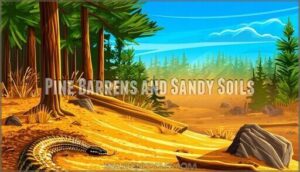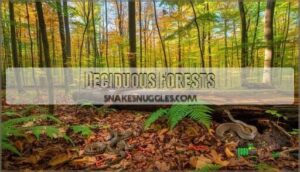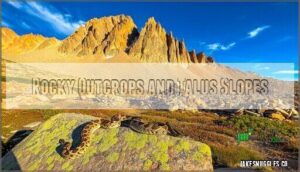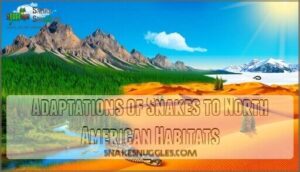This site is supported by our readers. We may earn a commission, at no cost to you, if you purchase through links.

Over 150 species call this continent home, each perfectly adapted to their environment.
Forest snakes like garter snakes thrive among leaf litter and fallen logs, while desert species have evolved specialized kidneys that conserve precious water.
Wetland champions like cottonmouths master both aquatic and terrestrial life, and grassland rattlers benefit from natural fire cycles that maintain their hunting grounds.
From Pacific Northwest rainforests to southeastern swamps, these remarkable reptiles have conquered virtually every ecosystem through millions of years of evolutionary fine-tuning, and have adapted to a wide range of environments, including desert sidewinders and eastern woodlands, with species like timber rattlesnakes and cottonmouths.
Table Of Contents
- Key Takeaways
- Diverse Snake Habitats Across North America
- Snakes in Northeastern North American Ecosystems
- Snake Habitats in Southeastern United States
- Western North America’s Snake-Rich Environments
- Adaptations of Snakes to North American Habitats
- Frequently Asked Questions (FAQs)
- Where do snakes live in the USA?
- Is North America the only continent with rattlesnakes?
- How far north do snakes live in North America?
- Where do snakes live in America?
- How do I find out which snake species live in a state?
- What is a snake habitat?
- Are there a lot of snakes in the United States?
- Which states are snake-free?
- Where do African snakes live?
- How far north in North America do snakes live?
- Conclusion
Key Takeaways
- You’ll find over 150 snake species thriving across North America’s diverse ecosystems, from desert sidewinders in the Sonoran to timber rattlesnakes in eastern woodlands
- Desert snakes have evolved specialized kidneys for water conservation and nocturnal behaviors, while forest species use leaf litter and logs for shelter and hunting grounds
- Each region offers unique habitats – southeastern swamps support cottonmouths, western chaparral hosts heat-adapted species, and northeastern pine barrens provide sandy soils perfect for burrowing snakes
- Snake survival depends on remarkable adaptations like advanced thermoregulation through basking and burrowing, specialized camouflage matching their environments, and seasonal activity patterns including hibernation strategies
Diverse Snake Habitats Across North America
North America’s diverse landscapes create perfect homes for over 100 snake species, from desert rattlers basking on sun-warmed rocks to water snakes gliding through marshland streams.
You’ll find these remarkable reptiles thriving everywhere from scorching southwestern deserts to cool mountain forests, each species perfectly adapted to its unique environmental niche.
These remarkable reptiles are found in various habitats, and their ability to thrive in different environments is a testament to their adaptability.
Forests and Woodlands
North American forests support over 150 forest snake species, creating nature’s ultimate hide-and-seek playground.
Woodlands offer perfect cover where 150+ snake species play nature’s ultimate game of hide-and-seek.
You’ll find these woodland snake diet specialists thriving from canopy snake habitats down to forest floor snakes in deciduous forests and oak woodlands. Some, like the Cottonmouth, are considered semi-aquatic.
Here are three key forest snake threats to remember:
- Habitat loss – Urban development fragments North American snakes’ woodland homes
- Road mortality – Forest snake species face traffic dangers during seasonal movements
- Fire suppression – Prevents natural forest renewal that benefits snake habitats
Deserts and Arid Regions
Beneath the blazing sun of North America’s deserts, over 50 snake species have mastered water conservation like desert survival experts. These Desert Snakes showcase incredible Rattlesnake Adaptations and Arid Camouflage strategies.
- Sidewinders navigate sandy Sonoran Desert terrain with unique sidewinding locomotion
- Western Diamondback Rattlesnakes dominate Mojave Desert hunting grounds
- Nocturnal activity helps avoid scorching daytime temperatures
- Specialized kidneys minimize water loss during Prey Scarcity periods
- Underground burrows provide essential thermal refuges
Grasslands and Prairies
Moving from arid deserts, Prairie snakes thrive in grasslands where fire ecology and bison impact shape their world.
You’ll find species like prairie rattlesnakes using prairie dog burrows for shelter and hunting grounds.
North American snakes in these grasslands benefit from conservation efforts that maintain open habitats through prescribed burns, supporting diverse snake ecosystems and healthy snake distribution patterns.
Wetlands and Riparian Areas
Wetlands and riparian areas serve as water highways for aquatic snakes like garter snakes and water snakes.
These North American snakes thrive in wetland ecosystems, supporting riparian foodwebs through predation on fish and amphibians.
However, habitat degradation and poor water quality threaten these snake habitats.
Wetland conservation protects these swimming serpents and their watery homes.
Maintaining proper humidity is essential, and humidity gauges help with adjustments.
Mountain and Alpine Ecosystems
When elevation reaches extreme heights, you’ll discover snake habitats in North America that showcase remarkable alpine ecosystems adaptations.
Mountain snakes have mastered surviving where oxygen runs thin and temperatures plummet.
- Elevation Adaptations – These reptiles develop specialized blood chemistry and metabolism to handle reduced oxygen levels effectively.
- Camouflage Strategies – Their patterns mirror rocky terrain perfectly, making them nearly invisible against granite surfaces.
- Hibernation Dens – They’ll seek deep rock crevices for winter survival in harsh alpine conditions.
- Limited Distribution – Prey Availability determines their range, as few species venture into these challenging snake alpine habitats.
Snakes in Northeastern North American Ecosystems
When you explore northeastern North America’s ecosystems, you’ll discover snakes thriving in surprisingly diverse habitats from pine barrens to rocky mountain slopes.
These adaptable reptiles have mastered everything from burrowing through sandy soils to traversing coastal marshes, making the Northeast a fascinating region for understanding snake ecology.
Pine Barrens and Sandy Soils
Within fire-dependent ecosystems, pine barrens create perfect snake habitats in North America.
Over 20 snake species, including specialized pine snakes, thrive in these sandy soils that allow easy burrowing. Some species even rely on specialized snake burrowing tools to enhance their underground dens.
Fire ecology maintains the open canopy these burrowing animals need, while soil composition provides ideal nesting sites.
Habitat conservation efforts protect these unique environments where snake species demonstrate remarkable snake habitat specificity.
Deciduous Forests
Deciduous forests offer sanctuary for North America’s most adaptable snake species.
These woodland havens provide perfect conditions with their leaf litter, fallen logs, and seasonal temperature changes that support diverse forest snake species throughout the year.
You’ll encounter these common forest floor snakes:
- Eastern garter snakes slithering through undergrowth
- Timber rattlesnakes basking near fallen trees
- Ring-necked snakes hiding under rotting logs
- Hognose snakes burrowing in soft soil
- Red-backed salamanders sharing forest food webs
Watch for increased activity during fall as they prepare for hibernation in forests.
Some snakes, like the copperhead, have elliptical pupils.
Rocky Outcrops and Talus Slopes
Beyond dense woodlands, you’ll discover that rocky outcrops and talus slopes create perfect snake habitat across North America’s mountainous regions.
These rugged landscapes offer excellent rock shelter and natural thermal gradients that help regulate body temperature.
| Feature | Benefit |
|---|---|
| Crevices & Ledges | Perfect hiding spots from predators |
| Sun-warmed Rocks | Essential basking areas for thermoregulation |
| Loose Stone Piles | Prey abundance – rodents and insects thrive here |
Snake species like timber rattlesnakes master camouflage strategies, blending seamlessly with lichen-covered stones.
Providing a safe reptile hide is vital for their well-being in captivity.
Conservation efforts protect these specialized habitats from development pressures.
Coastal Plains and Marshes
You’ll find estuarine snakes thriving in North America’s coastal plains and wetlands, where salinity tolerance becomes their superpower.
These marsh ecology specialists navigate changing water levels and coastal development pressures.
While habitat conservation efforts protect their brackish homes, making snake species like water snakes true coastal survivors.
Snake Habitats in Southeastern United States
You’ll discover the Southeast’s snake habitats are among North America’s most diverse, from fire-adapted longleaf pine savannas to mysterious cypress swamps.
These warm, humid ecosystems support everything from tiny ringneck snakes to massive eastern diamondbacks, making the region a snake enthusiast’s paradise, with habitats that are a true paradise.
Longleaf Pine Savannas
Longleaf pine savannas represent one of North America’s most biodiverse snake habitats, supporting 24 species in places like Texas’s Angelina National Forest.
These fire-maintained ecosystems create perfect conditions for snake conservation through their sandy soils and underground refugia.
Here are five key features that make longleaf pine savannas exceptional snake habitat:
- Gopher Tortoises create extensive burrow systems that Indigo Snakes and other species use for shelter and nesting
- Fire Ecology maintains open canopies through prescribed burns every 2-3 years, maximizing biodiversity impact
- Sandy substrates allow burrowing species like Louisiana Pine Snakes to excavate underground homes
- Pine barrens structure provides diverse microhabitats from xeric sandhills to mesic flatwoods
- Habitat Restoration efforts focus on restoring natural fire cycles to support native snake species across North America
Subtropical Hardwood Hammocks
You’ll discover that subtropical hardwood hammocks create North America’s most diverse snake habitat refuges in the Southeast.
These dense forests shelter Hammock Snake Species like Florida pine snakes among palms, oaks, and magnolias.
Hammock Microclimates support specialized Canopy Snake Behavior while Conservation Challenges from development threaten these fragile ecosystems.
- Dappled sunlight filtering through ancient oak canopies
- Serpentine trails winding between towering royal palms
- Morning mist rising from moss-draped hammock floors
Cypress Swamps and Bottomlands
Cypress swamps and bottomlands create wetlands where snake diversity thrives in North America.
These riparian areas offer prey abundance and flood tolerance for species like cottonmouths and water snakes.
However, habitat loss threatens water quality and delicate ecosystems.
You’ll find these snake habitat sanctuaries throughout southeastern bottomlands, where ancient cypress trees stand guard over nature’s perfectly balanced aquatic communities.
To enhance snake habitats, consider terrarium plant options.
Barrier Islands and Coastal Dunes
You’ll find dune snake species thriving along North America’s dynamic coastal plains and barrier islands despite challenging conditions.
These resilient reptiles demonstrate remarkable salinity tolerance, adapting to salt-spray environments where coastal erosion impact constantly reshapes their world.
Storm surge effects and island habitat loss threaten these specialized snake species, yet they persist in this ever-changing snake habitat.
Western North America’s Snake-Rich Environments
You’ll discover that western North America hosts some of the continent’s most specialized snake communities, from heat-loving desert rattlers to moisture-dependent rainforest species.
These diverse environments—spanning scorching deserts, Mediterranean-like chaparral, high-elevation steppes, mountain foothills, and misty coastal forests—create unique niches that different snake species have mastered over thousands of years, allowing them to thrive in their respective environments.
Sonoran and Mojave Deserts
From the subtropical southeastern forests, you’ll encounter North America’s most impressive desert snakes in the Sonoran and Mojave deserts.
These arid regions host specialized snake species with remarkable water conservation abilities. Desert Snakes like rattlesnakes have developed Arid Adaptations including heat-resistant scales and efficient kidney function.
The Sonoran Desert supports sidewinder rattlesnakes, while the Mojave Desert houses species with potent Rattlesnake Venom. Desertification Impacts continue reshaping these ecosystems, making conservation efforts essential.
Desert Snake Survival Tactics
- Heat management – Snakes burrow underground during scorching midday temperatures, emerging at dawn and dusk
- Water wizardry – They extract moisture from prey since water sources are scarce across these deserts
- Camouflage mastery – Desert rattlesnakes blend perfectly with sandy terrain and rocky outcrops
Chaparral and Oak Woodlands
The chaparral and oak woodlands create a Mediterranean-style habitat where snakes face unique challenges.
Fire ecology shapes this landscape, forcing species to adapt quickly.
Oak diversity provides varied microhabitats, while water scarcity tests survival skills.
| Adaptation Strategy | Survival Benefit |
|---|---|
| Heat-reflective scales | Prevents overheating in sun |
| Burrowing behavior | Escapes fire and extreme temps |
| Seasonal activity shifts | Avoids driest periods |
| Camouflage patterns | Matches oak bark and dried grass |
| Efficient water retention | Survives prolonged droughts |
Sagebrush Steppe
Moving from oak woodlands to sagebrush steppe, you’ll find snakes perfectly adapted to this harsh environment.
Sagebrush snakes rely on steppe biodiversity for survival, with prey abundance fluctuating seasonally.
- Snake species like gopher snakes hunt rodents among sagebrush.
- Fire ecology shapes snake habitat by creating hunting corridors.
Conservation efforts protect this fragile North America ecosystem where snake diet depends on small mammals.
Snakes in this region often use burrowing for temperature regulation to survive the extreme temperatures.
Rocky Mountain Foothills
You’ll find foothill snakes thriving at moderate elevations where prey abundance meets perfect elevation adaptations.
Rocky Mountain foothills host specialized snake species that master winter hibernation in rocky crevices.
However, conservation challenges threaten these North America habitats, making snake habitat restoration and snake conservation efforts essential for survival.
Pacific Northwest Temperate Rainforests
After the rugged Rocky Mountain foothills, you’ll step into the Pacific Northwest’s temperate rainforests—where moss blankets the ground and Temperate Snakes rule the undergrowth.
Here, snake species like garter snakes and rubber boas thrive thanks to Amphibian Symbiosis and Unique Adaptations.
These lush forests highlight Rainforest Ecology but also face Conservation Challenges, making snake habitat restoration efforts more important than ever.
Adaptations of Snakes to North American Habitats
You’ll discover how North American snakes have evolved remarkable strategies to thrive in environments from scorching deserts to frozen tundra.
These adaptations showcase nature’s ingenuity in solving survival challenges across the continent’s diverse landscapes, highlighting remarkable strategies.
Burrowing and Fossorial Behaviors
You’ll discover snake adaptations that make North America’s burrowing species true underground architects.
Soil types directly influence burrow creation strategies across diverse North American habitats:
- Sandy substrates allow easy excavation for pine snakes and racers
- Clay soils require powerful bodies like those of tunnel systems builders
- Rocky terrain forces snakes to utilize existing crevices and gaps
- Substrate preferences vary by species’ morphological adaptations
- Predator avoidance drives deep tunnel systems in open grasslands
Snake behavior shows remarkable plasticity in snake habitat selection. These species have evolved specialized adaptive traits.
Thermoregulation Strategies
You’ll find North American snakes have mastered thermoregulation strategies through basking behavior on rocks and logs, shade-seeking under vegetation during heat, and hibernation strategies in burrows or dens.
These physiological adaptations help snakes maintain ideal body temperature across diverse climates.
Climatic tolerance varies by species, from desert rattlesnakes to mountain-dwelling timber rattlers throughout North America.
Camouflage and Mimicry
North American snakes are masters of disguise, using coloration strategies that would make a magician jealous.
You’ll spot timber rattlesnakes blending perfectly with fallen leaves, while coral snakes use bright warning colors in their mimicry types.
Pattern disruption breaks up their body outline, and behavioral camouflage includes freezing when threatened.
These snake adaptations help with predator evasion—it’s nature’s ultimate hide-and-seek game.
Seasonal Activity Patterns
You’ll notice snakes aren’t equally active all year long.
Hibernation slows them down during winter months, while breeding seasons in spring trigger increased movement.
Migration patterns shift with food availability and temperature changes.
Some species enter aestivation periods during extreme heat.
Diurnal activity varies seasonally—spring brings dawn hunting, summer means nighttime prowls.
Thermoregulation drives these seasonal rhythms completely.
Dietary Specializations
You’ll find fascinating dietary specializations help snakes thrive across North America’s diverse habitats.
Specialized feeding strategies help North American snakes dominate every habitat from deserts to rainforests
These adaptations reveal nature’s remarkable engineering:
- Venom Composition varies dramatically—coral snakes target nervous systems while rattlesnakes destroy tissue, matching their prey preferences perfectly.
- Constriction Methods differ between species, with kingsnakes using precise coiling techniques for snake prey versus rodent-hunting constrictors.
- Digestion Efficiency allows snakes extended feeding frequency, processing meals over weeks through specialized enzymes and expandable stomachs.
Frequently Asked Questions (FAQs)
Where do snakes live in the USA?
You’ll find snakes across America’s diverse landscapes—from Florida’s swamps to Arizona’s deserts. They thrive in forests, grasslands, wetlands, rocky areas, and surprisingly, your neighborhood parks and backyards too.
Is North America the only continent with rattlesnakes?
No, rattlesnakes aren’t exclusive to North America.
You’ll find them throughout the Americas, from Canada down to Argentina.
South America hosts several species, while North America has the greatest diversity with over thirty different rattlesnake species.
How far north do snakes live in North America?
You’ll find snakes living surprisingly far north in Canada, reaching areas near the Arctic Circle. However, most species can’t handle harsh winters beyond southern Canada’s borders.
Where do snakes live in America?
You’ll find snakes across America in forests, deserts, grasslands, wetlands, and even your backyard. They’ve adapted to nearly every habitat from hot southwestern deserts to cool northern woods.
How do I find out which snake species live in a state?
Like a detective following clues, you’ll want to check your state’s wildlife agency website or field guides.
Most states publish official snake species lists with photos and habitat info, making identification easier than finding a needle in a haystack.
This information can be very useful for identification purposes.
What is a snake habitat?
A snake’s home includes forests, deserts, wetlands, grasslands, and rocky areas where they find food, shelter, and mates.
You’ll spot them basking in sunny spots, hiding under logs, or swimming in streams.
Are there a lot of snakes in the United States?
You’ll discover a serpent’s paradise across America, with over 100 native snake species slithering from coast to coast. Texas leads with 68 species, while Florida hosts 46 different varieties in diverse habitats.
Which states are snake-free?
Alaska is the only U.S. state that’s completely snake-free. The harsh, cold climate makes it impossible for snakes to survive year-round there, giving Alaskans one less wildlife worry.
Where do African snakes live?
Absolutely everywhere you’d expect them!
African snakes thrive across the continent’s incredible diversity—from humid rainforests and grasslands to blazing deserts, rocky outcrops, and savannas.
They are perfectly adapted to their chosen environments, from humid rainforests and grasslands to blazing deserts, rocky outcrops, and savannas.
How far north in North America do snakes live?
You’ll find North America’s hardiest snakes pushing boundaries all the way to Canada’s southern regions.
While most species can’t handle freezing winters, some garter snakes actually thrive near the Arctic Circle.
Conclusion
Absolutely mind-blowing diversity defines snake habitat in North America, where evolution has crafted specialists for every conceivable niche.
You’ve discovered how these incredible reptiles thrive from scorching deserts to frozen mountain slopes, each species perfectly matched to its environment.
Whether you’re hiking through rattlesnake country or exploring wetland trails, you’ll now recognize the amazing adaptations that make each habitat unique.
Understanding these ecosystems helps you appreciate nature’s remarkable problem-solving abilities and respect these fascinating creatures in their homes, which is a truly mind-blowing experience that showcases the diversity of snake habitats.
- https://a-z-animals.com/animals/snake/snake-facts/snake-population-state/
- https://mdc.mo.gov/sites/default/files/mo_nature/downloads/page/MissouriSnakes.pdf
- https://en.wikipedia.org/wiki/Eastern_garter_snake
- https://scz.org/blog/whats-that-sound-its-one-of-north-americas-most-adaptive-reptiles-the-rattlesnake
- https://www.techexplorist.com/how-species-snakes-evolved-adapted/77964/

















